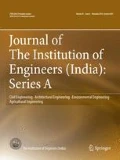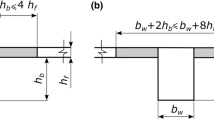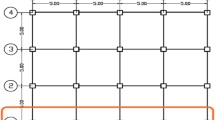Abstract
Failure and collapse of structures due to natural or man-made catastrophes have become a consistent concern worldwide. The existence of a wide variation of high-rise structures in the past literature has made it difficult to study their geometrical orientation, locus and other physical and mechanical assets in their revision of design or retrofitting of various segments. This paper is presented with an objective to review existing buildings and building models from the previous literature and discuss their performance under variety of dynamic uncertainties. The fundamental geophysical and modelling assumptions, the varying parameters and data needed for their behaviour determination, along with the limitations of discussed models are summarised. Current study deals with building typologies like moment-resisting frames, shear wall structures, dual systems and structures with soft storey to analyse their behaviour under various loading conditions. These typologies have been considered for failure occurrences owing to effect of connections, soil underneath and progressive collapse. The present study involves only various building typologies and their typical failure occurrences, and hence structural control has not been taken into account. The last section of the study involves the literature on fuzzy logic and some of its application in enhancing structural behaviour in more realistic manner. Although the literature contains a wide variety of structural frames, effort has been put to quantize and summarise them for the last twenty-five years in nutshell for more relevant and smooth research process.








Similar content being viewed by others
References
S. Aaleti, S. Sritharan, A simplified analysis method for characterizing unbonded post-tensioned precast wall systems. Eng. Struct. 31(12), 2966–2975 (2009)
H. Adeli, X. Jiang, Dynamic fuzzy wavelet neural network model for structural system identification. J. Struct. Eng. 132(1), 102–111 (2006)
S. Ali, F. Malik, T. Sonone, B. Kalbande, H. Agale, Analysis of building with soft storey during earthquake. Int. Res. J. Eng. Technol. (IRJET) 4(3), 1005–1009 (2017)
A. Arede, A. Pinto, On the seismic behaviour of RC frames designed according to Eurocode 8, in Proceedings of 12th World Conference on Earthquake Engineering (2000)
P.G. Asteris, A method for the modelling of infilled frames (method of contact points), in Proceedings of 11th World Conference on Earthquake Engineering (1996)
L. Astriana, S. Sangadji, E. Purwanto, S.A. Kristiawan, Assessing seismic performance of moment resisting frame and frame-shear wall system using seismic fragility curve. Procedia Eng. 171, 1069–1076 (2017)
M. Babaei, F. Omidi, Determining the optimum spans for special steel moment resisting frames with special eccentric braces. Res. J. Appl. Sci. 10(9), 474–478 (2015)
Y. Bao, S.K. Kunnath, Simplified progressive collapse simulation of RC frame–wall structures. Eng. Struct. 32(10), 3153–3162 (2010)
M.A. Basaran, Calculating fuzzy inverse matrix using fuzzy linear equation system. Appl. Soft Comput. 12(6), 1810–1813 (2012)
D. Behera, S. Chakraverty, Fuzzy finite element analysis of imprecisely defined structures with fuzzy nodal force. Eng. Appl. Artif. Intell. 26, 2458–2466 (2014)
R. Bento, J. Azevedo, Behaviour coefficient assessment for soft storey structures, in Proceedings of the 12th World Conference on Earthquake Engineering (Auckland, 2000)
R. Bento, M. Lopes, Evaluation of the need for weak beam strong column design in dual frame–wall structures, in Proceedings of the 12th World Conference on Earthquake Engineering (Auckland, 2000)
F. Biondini, F. Bontempi, P.G. Malerba, Fuzzy reliability analysis of concrete structures. Comput. Struct. 82(13), 1033–1052 (2004)
G.E. Blandford, Review of progressive failure analyses for truss structures. J. Struct. Eng. 123(2), 122–129 (1997)
M. Brun, J.M. Reynouard, L. Jezequel, N. Ile, Damaging potential of low-magnitude near-field earthquakes on low-rise shear walls. Soil Dyn. Earthq. Eng. 24(8), 587–603 (2004)
P.P. Chandurkar, P.S. Pajgade, Seismic analysis of RCC building with and without shear wall. Int. J. Mod. Eng. Res. (IJMER) 3(3), 1805–1810 (2013)
C.J. Chao, F.P. Cheng, Fuzzy pattern recognition model for diagnosing cracks in RC structures. J. Comput. Civ. Eng. 12(2), 111–119 (1998)
K.C. Chou, J. Yuan, Fuzzy-Bayesian approach to reliability of existing structures. J. Struct. Eng. 119(11), 3276–3290 (1993)
P.S. Dande, P.B. Kodag, Influence of provision of soft storey in RC frame building for earthquake resistance design. Int. J. Eng. Res. Appl. 3(2), 461–468 (2013)
Z.T. Değer, J.W. Wallace, Seismic performance of reinforced concrete dual-system buildings designed using two different design methods. Struct. Des. Tall Spec. Build. 25(1), 45–59 (2015)
B.S. Dhillon, J.W.O. Malley, Interactive design of semi rigid steel frames. J. Struct. Eng. 125(5), 556–564 (1999)
M. Divan, M. Madhkhan, Determination of behavior coefficient of prefabricated concrete frame with prefabricated shear walls. Procedia Eng. 14, 3229–3236 (2011)
M. Dogan, E. Unluoglu, H. Ozbasaran, Earthquake failures of cantilever projections buildings. Eng. Fail. Anal. 14(8), 1458–1465 (2007)
M. Dolšek, P. Fajfar, The effect of masonry infills on the seismic response of a four-storey reinforced concrete frame—a deterministic assessment. Eng. Struct. 30(7), 1991–2001 (2008)
V. Drosos, T. Georgarakos, M. Loli, I. Anastasopoulos, G. Gazetas, Nonlinear soil–foundation interaction: an experimental study on sand, in Proceedings of 2nd International Conference on Performance-based Design in Earthquake Geotechnical Engineering (2012)
A.S. Elnashai, A.Y. Elghazouli, Seismic behaviour of semi-rigid steel frames. J. Constr. Steel Res. 29(1), 149–174 (1994)
A.A. Farghaly, Seismic analysis of adjacent buildings subjected to double pounding considering soil–structure interaction. Int. J. Adv. Struct. Eng. 9(1), 51–62 (2017)
I. Faridmehr, M.M. Tahir, T. Lahmer, Classification system for semi-rigid beam-to-column connections. Lat. Am. J. Solids Struct. 13(11), 2152–2175 (2016)
M. Fintel, Performance of buildings with shear walls in earthquakes of the last thirty years. PCI J. 40(3), 62–80 (1995)
A. Fiore, A. Netti, P. Monaco, The influence of masonry infill on the seismic behaviour of RC frame buildings. Eng. Struct. 44, 133–145 (2012)
F. Fu, Progressive collapse analysis of high-rise building with 3-D finite element modeling method. J. Constr. Steel Res. 65(6), 1269–1278 (2009)
N. Fukuwa, M.A. Ghannad, Soil–structure interaction effect on the Eigen properties of structure, in Proceedings of 11th World Conference on Earthquake Engineering (1996)
V.S. Gawade, V.S. Shingade, Seismic response of multi-storeyed reinforced concrete dual system with and without shear walls. Int. J. Sci. Eng. Technol. Res. (IJSETR) 6(1), 77–80 (2017)
T. Gengshu, Y.L. Pi, M.A. Bradford, F. Tin-Loi, Buckling and second-order effects in dual shear-flexural systems. J. Struct. Eng. 134(11), 1726–1732 (2008)
B. Ghosh, S.P.G. Madabhushi, Dynamic soil–structure interaction for layered and inhomogeneous ground, in Proceedings of 13th World Conference on Earthquake Engineering (Vancouver, Canada, 2004)
L.T. Guevara, M. Paparoni, Soft stories treatment in the municipal ordinances of a hazardous sector of Caracus, Venezuela, in Proceedings of the 11th World Conference on Earthquake Engineering (Acapulco, Mexico, 1996)
M.A. Hadianfard, R. Razani, Effects of semi-rigid behavior of connections in the reliability of steel frames. Struct. Saf. 25(2), 123–138 (2003)
N.H. Hamid, J.B. Mander, Lateral seismic performance of multipanel precast hollowcore walls. J. Struct. Eng. 136(7), 795–804 (2010)
S.W. Han, N. Jee, Seismic behaviors of columns in ordinary and intermediate moment resisting concrete frames. Eng. Struct. 27(6), 951–962 (2005)
M. Hayalioglu, S. Degertekin, Minimum cost design of steel frames with semi-rigid connections and column bases via genetic optimization. Comput. Struct. 83(21), 1849–1863 (2005)
F. Hejazi, S. Jilani, J. Noorzaei, C.Y. Chieng, M.S. Jaafar, A.A. Ali, Effect of soft story on structural response of high rise buildings, in IOP Conference Series: Materials Science and Engineering, vol. 17(1), pp. 012–034 (2011)
A.M. Ioani, E. Tripa, Structural behavior of an innovative all-precast concrete dual system for residential buildings. PCI J. 57(1), 110–123 (2012)
M.S. Islam, M.P. Nepal, M. Skitmore, M. Attarzadehpa, Current research trends and application areas of fuzzy and hybrid methods to the risk assessment of construction projects. Adv. Eng. Inform. 33(1), 112–131 (2017)
R. Jeyanthi, S.M. Kumar, Progressive collapse analysis of a multistorey RCC building using pushover analysis. Int. J. Eng. Res. Technol. 5(3), 747–750 (2016)
G. Kaewkulchai, E.B. Williamson, Beam element formulation and solution procedure for dynamic progressive collapse analysis. Comput. Struct. 82(7), 639–651 (2004)
V.D. Kapgate, K.N. Kadam, Response of semi rigid connections on frame behaviour. Int. J. Recent Innov. Trends Comput. Commun. 3(2), 37–40 (2015)
A.J. Kappos, Evaluation of behaviour factors on the basis of ductility and overstrength studies. Eng. Struct. 21(9), 823–835 (1999)
M.E. Kartal, H.B. Basaga, A. Bayraktar, M. Muvafik, Effects of semi-rigid connection on structural responses. Electron. J. Struct. Eng. 10(10), 22–35 (2010)
M.N. Kataoka, M.A. Ferreira, A.L.H.C.E. Debs, A study on the behavior of beam–column connections in precast concrete structures: experimental analysis. Rev. IBRACON de Estruturas e Materiais 5(6), 848–873 (2012)
H.B. Kaushik, S.K. Jain, Impact of great december 26, 2004 sumatra earthquake and tsunami on structures in Port Blair. J. Perform. Constr. Facil. 21(2), 128–142 (2007)
A. Keyhani, S.M.R. Shahabi, Fuzzy connections in structural analysis. Mechanics 18(4), 380–386 (2012)
L. Khalil, M. Sadek, I. Shahrour, Influence of the soil–structure interaction on the fundamental period of buildings. Earthq. Eng. Struct. Dyn. 36, 2445–2453 (2007)
S. Kiggins, C.M. Uang, Reducing residual drift of buckling-restrained braced frames as a dual system. Eng. Struct. 28, 1525–1532 (2006)
J. Kim, S. Hong, Progressive collapse performance of irregular buildings. Struct. Des. Tall Spec. Build. 20(6), 721–734 (2011)
H.S. Kim, J. Kim, D.W. An, Development of integrated system for progressive collapse analysis of building structures considering dynamic effects. Adv. Eng. Softw. 40(1), 1–8 (2009)
N. Kirac, M. Dogan, H. Ozbasaran, Failure of weak-storey during earthquakes. Eng. Fail. Anal. 18(2), 572–581 (2010)
N. Kishi, W.F. Chen, Y. Goto, R. Hasan, Behavior of tall buildings with mixed use of rigid and semi-rigid connections. Comput. Struct. 61(6), 1193–1206 (1996)
P.S. Kumbhare, A.C. Saoji, Effectiveness of changing reinforced concrete shear wall location on multi-storeyed building. Int. J. Eng. Res. Appl. 2(5), 1072–1076 (2012)
H.S. Lee, D.W. Ko, Seismic response of high-rise RC bearing-wall structures with irregularities at bottom stories, in Proceedings of the 13th World conference on Earthquake Engineering (CD ROM, Vancouver, 2004)
B. Li, Q. Chen, Initial stiffness of reinforced concrete structural walls with irregular openings. Earthq. Eng. Struct. Dyn. 39(4), 397–417 (2009)
M. Li, X. Lu, X. Lu, L. Ye, Influence of soil–structure interaction on seismic collapse resistance of super-tall buildings. J. Rock Mech. Geotech. Eng. 6(5), 477–485 (2014)
G. Li, Z. Lu, J. Xu, A fuzzy reliability approach for structures based on the probability perspective. Struct. Saf. 54, 10–18 (2015)
T. Magendra, A. Titiksh, A.A. Qureshi, Optimum positioning of shear walls in multistorey buildings. Int. J. Trend Res. Dev. 3(3), 666–671 (2016)
D. Markulak, I. Radić, V. Sigmund, Cyclic testing of single bay steel frames with various types of masonry infill. Eng. Struct. 51, 267–277 (2013)
L. Martinelli, Numerical modelling of a PSD test on a dual RC system, in Proceedings of 13th World Conference on Earthquake Engineering (Vancouver, Canada, 2004)
E. Masoero, F.K. Wittel, H.J. Herrmann, B.M. Chiaia, Progressive collapse mechanisms of brittle and ductile framed structures. J. Eng. Mech. 136(8), 987–995 (2010)
L. Mastrandrea, V. Piluso, Plastic design of eccentrically braced frames, II: failure mode control. J. Constr. Steel Res. 65(5), 1015–1028 (2009)
J.A. Munshi, S.K. Ghosh, Analyses of seismic performance of a code designed reinforced concrete building. Eng. Struct. 20(7), 608–616 (1998)
D. Muria-Vila, R.G. Alcorta, Soil–structure interaction effects in a building, in Proceedings of The 10th World Conference on Earthquake Engineering (1992)
S. Muruganandam, K.A. Razak, Matrix inversion method for solving fully fuzzy linear systems with triangular fuzzy numbers. Int. J. Comput. Appl. 65(4), 9–11 (2013)
C. Nabin Raj, S. Elavenil, Analytical study on seismic performance of hybrid (dual) structural system subjected to earthquake. Int. J. Mod. Eng. Res. 2(4), 2358–2363 (2012)
A.S. Naphade, G.R. Patil, Pushover analysis of RCC building with soft storey at different levels. IOSR J. Mech. Civ. Eng. 1(17), 100–108 (2015)
D.A. Nethercot, T.Q. Li, B. Ahmed, Unified classification system for beam-to-column connections. J. Constr. Steel Res. 45(1), 39–65 (1998)
A. Osman, A. Ghobarah, R.M. Korol, Seismic performance of moment resisting frames with flexible joints. Eng. Struct. 15(2), 117–134 (1993)
T. Otsuka, W.N. Sui, M. Yamanari, Design parameters of semi-rigid connections through static steel frame analysis, in Proceedings of the 14th World Conference on Earthquake Engineering (2008)
F. Pakdamar, K. Güler, Fuzzy logic approach in the performance evaluation of reinforced concrete structures (flexible performance), in Proceedings of the 14th World Conference on Earthquake Engineering (Beijing, China, 2008), pp. 12–17
P.G. Papadopoulos, Simple analysis of RC frame with soft storey, in Proceedings of the 10th World Conference on Earthquake Engineering (1992), pp. 4287–4292
V. Patil, P.M. Devikrishna, Design of shear wall in seismic region. Int. J. Sci. Eng. Res. 5(12), 80–82 (2014)
N. Patnala, P.K. Ramancharla, Effect of soft storey in a structure present in higher seismic zone areas, in Urban Safety of Mega Cities in Asia (USMCA) (2014), pp. 12–17
S.C. Patodi, J.M. Chauhan, First order analysis of plane frames with semi-rigid connections, in Proceedings of National Conference on Recent Trends in Engineering and Technology (Gujarat, 2011), pp. 13–14
O.A. Pekau, Y. Cui, Progressive collapse simulation of precast panel shear walls during earthquakes. Comput. Struct. 84(5), 400–412 (2006)
H.A. Pham, X.T. Nguyen, V.H. Nguyen, Fuzzy structural analysis using improved differential evolutionary optimization, in Proceedings of the International Conference on Engineering Mechanics and Automation (ICEMA 3) (Hanoi, 2014), pp. 492–498
S. Pujol, D. Fick, The test of a full-scale three-story RC structure with masonry infill walls. Eng. Struct. 32(10), 3112–3121 (2010)
K.G. Rakshith, Radhakrishna, Progressive collapse analysis of reinforced concrete framed structure. International Journal of Research in Engineering and Technology, IC-RICE Conference Issue, pp. 36–40 (2013)
I. Rashid, M. Gavalec, R. Cimler, Eigenspace structure of a max-pod fuzzy matrix. Fuzzy Sets Syst. 303, 136–148 (2016)
G.D. Rathod, S.S. Hande, A.V. Gorle, Optimum performance of shear wall frame structure by changing location of shear wall. Int. J. Innov. Res. Sci. Eng. Technol. 6(4), 5503–5509 (2017)
P. Raychowdhury, T.C. Hutchinson, Performance evaluation of a nonlinear Winkler-based shallow foundation model using centrifuge test results. Earthq. Eng. Struct. Dyn. 38(5), 679–698 (2009)
F.H. Rezvani, G. Mohammadi, A.S. Majid, Seismic progressive collapse analysis of concentrically braced frames through incremental dynamic analysis, in Proceedings of The 15th World conference on Earthquake Engineering (2012)
R. Sadjadi, M.R. Kianoush, S. Talebi, Seismic performance of reinforced concrete moment resisting frames. Eng. Struct. 29(9), 2365–2380 (2007)
E. Safak, Detection and identification of soil–structure interaction in buildings from vibration recordings. J. Struct. Eng. 121(5), 899–906 (1995)
K.C. Sarma, H. Adeli, Fuzzy genetic algorithm for optimization of steel structures. J. Struct. Eng. 126(5), 596–604 (2000)
Y. Sato, H. Kuwamura, Dynamic progressive failure of multistorey frames having brittle columns, in Proceedings of The 11th World Conference on Earthquake Engineering (1996)
M.H. Serror, M.N. Abdelmoneam, Seismic performance evaluation of egyptian code-designed steel moment resisting frames (in press). HBRC J. (2016). https://doi.org/10.1016/j.hbrcj.2016.01.005. (in press)
L.M.C. Simoes, Optimization of frames with semi-rigid connections. Comput. Struct. 60(4), 531–539 (1996)
R.S. Singh, Y. Jamal, M.A. Khan, Progressive collapse analysis of reinforced concrete symmetrical and unsymmetrical framed structures by ETABS. Int. J. Innov. Res. Adv. Eng. (IJIRAE) 2(12), 78–83 (2015)
D.P. Soni, B.B. Mistry, Qualitative review of seismic response of vertically irregular building frames. ISET J. Earthq. Technol. 43(4), 121–132 (2006)
U. Starossek, M. Wolff, Progressive collapse: design strategies, in Proceedings of IABSE Symposium Lisbon (2005), pp. 1–8
L.T. Stavridis, Simplified analysis of layered soil–structure interaction. J. Struct. Eng. 128(2), 224–230 (2002)
J.P. Stewart, R.B. Seed, G.L. Fenves, Seismic soil–structure interaction in buildings. II: empirical findings. J. Geotech. Geoenviron. Eng. 125(1), 38–48 (1999)
J.P. Stewart, G.L. Fenves, R.B. Seed, Seismic soil–structure interaction in buildings. I: analytical methods. J. Geotech. Geoenviron. Eng. 125(1), 26–37 (1999)
H.R. Tabatabaiefar, A. Massumi, A simplified method to determine seismic responses of reinforced concrete moment resisting building frames under influence of soil–structure interaction. Soil Dyn. Earthq. Eng. 30(11), 1259–1267 (2010)
Y. Tang, J. Zhang, Probabilistic seismic demand analysis of a slender RC shear wall considering soil–structure interaction effects. Eng. Struct. 33(1), 218–229 (2011)
S. Tesfamariam, Z. Liu, Earthquake induced damage classification for reinforced concrete buildings. Struct. Saf. 32(2), 154–164 (2010)
C. Topkaya, C.O. Kurban, Natural periods of steel plate shear wall systems. J. Constr. Steel Res. 65(3), 542–551 (2009)
N.W. Trombetta, H.B. Mason, T.C. Hutchinson, J.D. Zupan, J.D. Bray, B.L. Kutter, Non linear soil–foundation–structure and structure–soil–structure interaction. J. Struct. Eng. 141(7), 1–12 (2015)
R. Vaghei, F. Hejazi, H. Taheri, M.S. Jaafar, F.N.A.A. Aziz, Development of a new connection for precast concrete walls subjected to cyclic loading. Earthq. Eng. Eng. Vib. 16(1), 97–117 (2017)
A. Vulpe, A. Carausu, Fuzzy logic models for seismic damage analysis and prediction, in Proceedings of the 14th World Conference on Earthquake Engineering (2008)
T. Wang, Q. Chen, H. Zhao, L. Zhang, Experimental study on progressive collapse performance of frame with specially shaped columns subjected to middle column removal. Shock Vib. 1–13 (2016)
Q. Wang, L. Wang, Q. Liu, Effect of shear wall height on earthquake response. Eng. Struct. 23(4), 376–384 (2001)
Z.P. Wen, Y.X. Hu, K.T. Chau, Site effect on vulnerability of high-rise shear wall buildings under near and far field earthquakes. Soil Dyn. Earthq. Eng. 22(9), 1175–1182 (2002)
A. Wibowo, J.L. Wilson, N.T.K. Lam, E.F. Gad, Collapse modelling analysis of a precast soft storey building in Australia. Eng. Struct. 32(7), 1925–1936 (2010)
L.A. Wyllie, Analysis of the collapsed Armenian precast concrete frame buildings, in Proceedings of the 10th World Conference on Earthquake Engineering (1992)
P.M. Yesane, Y.M. Ghugal, R.L. Wankhade, Study on soil–structure interaction: a review. Int. J. Eng. Res. 5(3), 737–741 (2016)
A.M. Yousef, S.E. El-Metwally, M.A. El-Mandouh, Seismic performance of hsc dual systems irregular in elevation. Ain Shams Eng. J. 5(2), 321–332 (2014)
L.A. Zadeh, Fuzzy sets. Inf. Control 8(3), 338–353 (1965)
Q. Zhang, Y. Li, The performance of resistance progressive collapse analysis for high-rise frame-shear structure based on opensees. Shock Vib. 2017, 1–13 (2017)
Author information
Authors and Affiliations
Corresponding author
Rights and permissions
About this article
Cite this article
De, S., Dhang, N. A Literature Review on Building Typology and Their Failure Occurrences. J. Inst. Eng. India Ser. A 100, 177–190 (2019). https://doi.org/10.1007/s40030-018-0326-3
Received:
Accepted:
Published:
Issue Date:
DOI: https://doi.org/10.1007/s40030-018-0326-3




